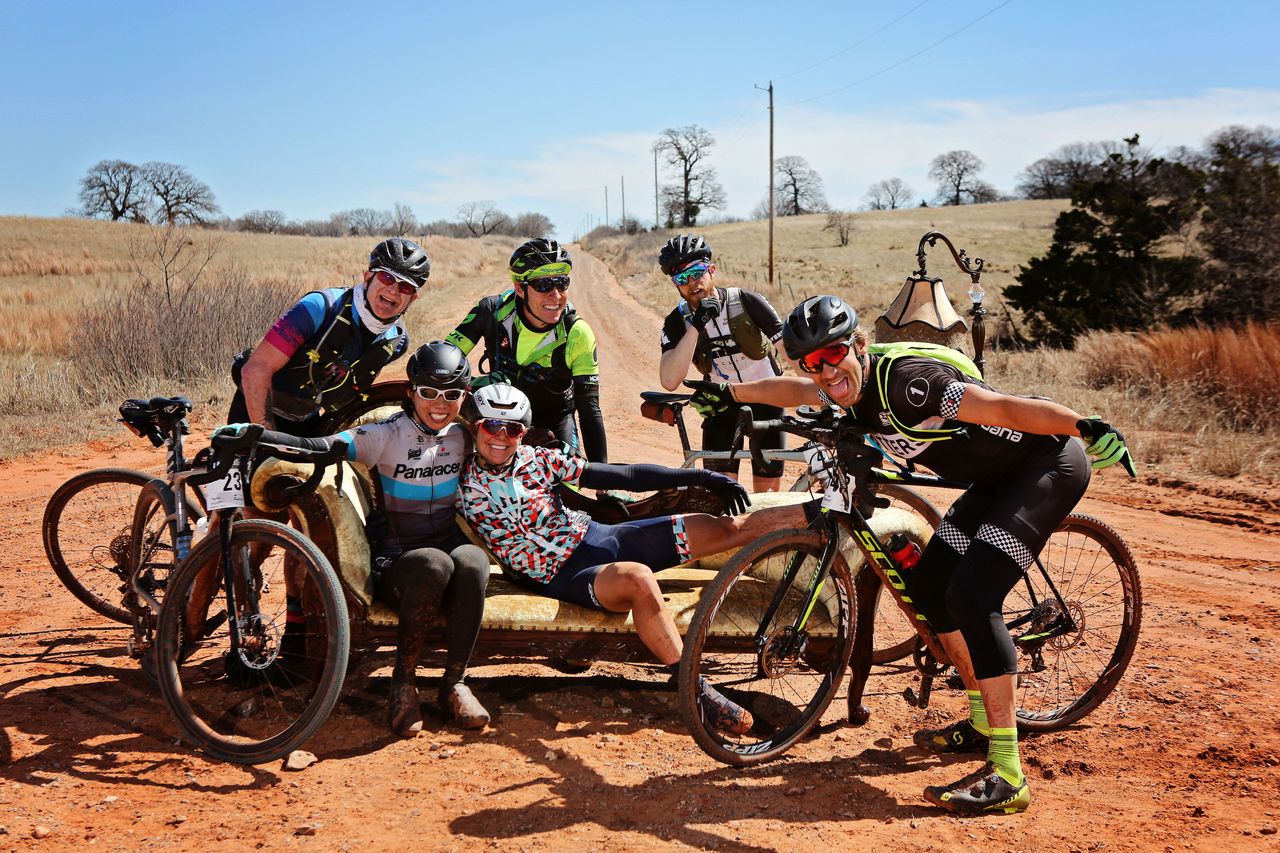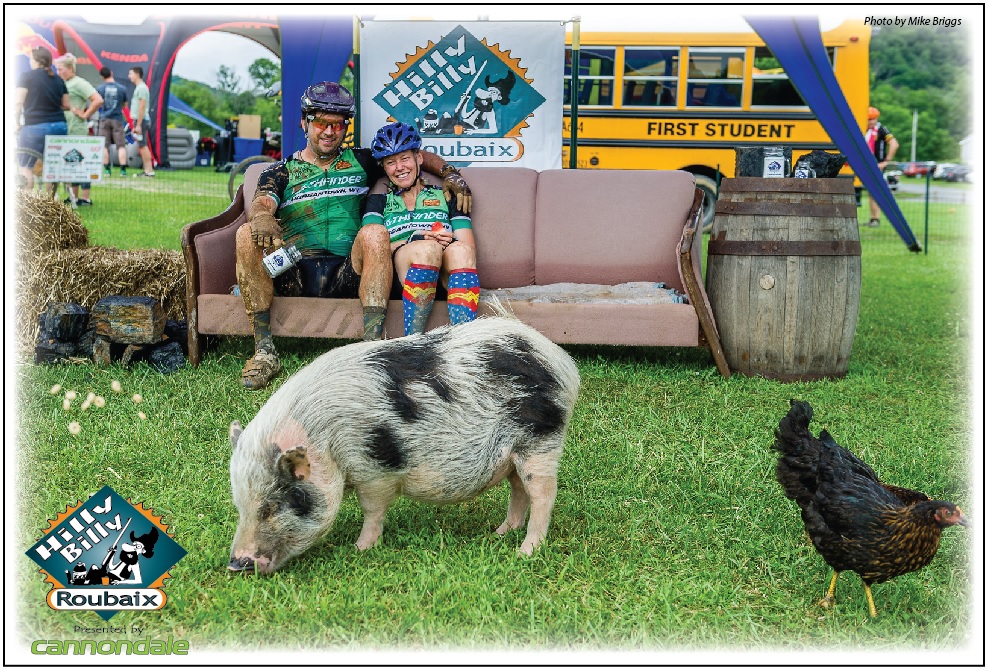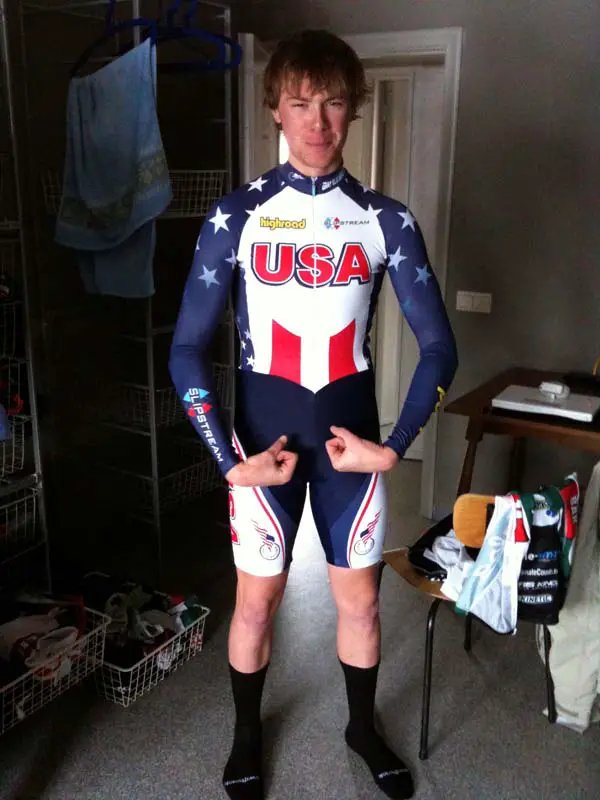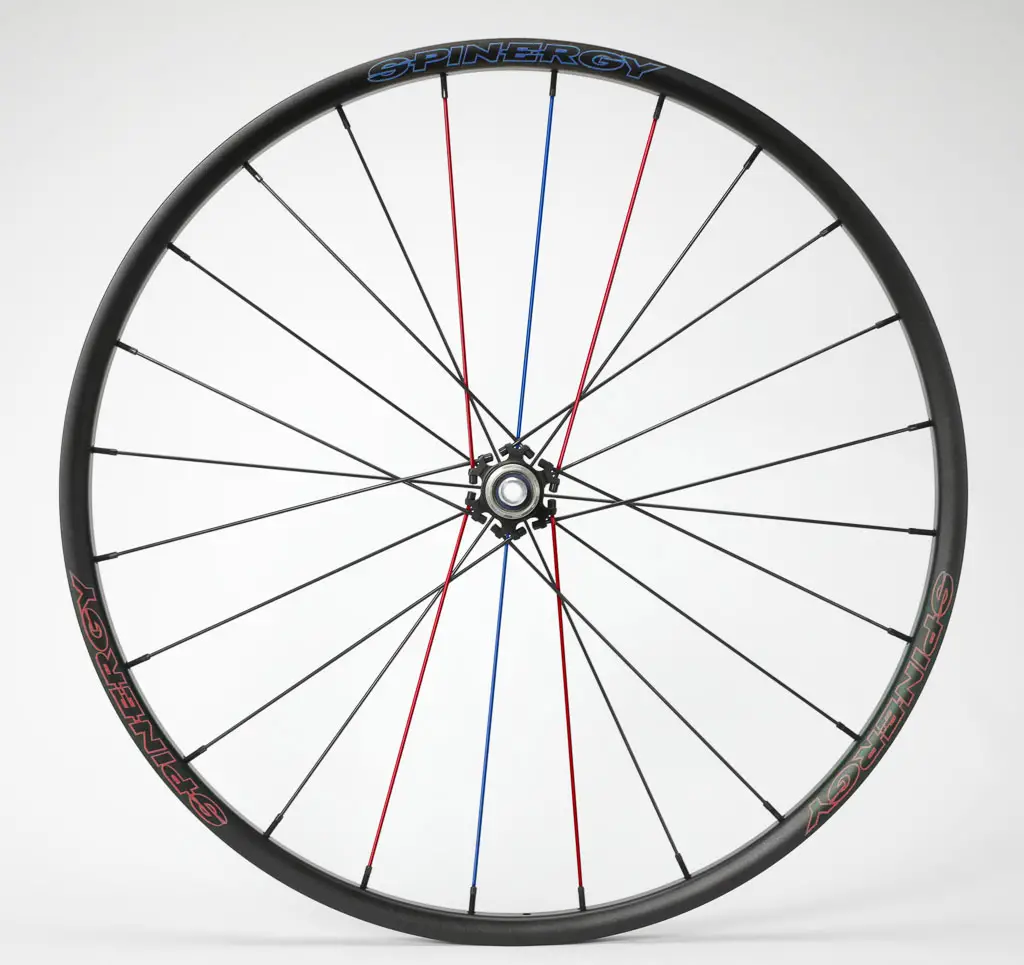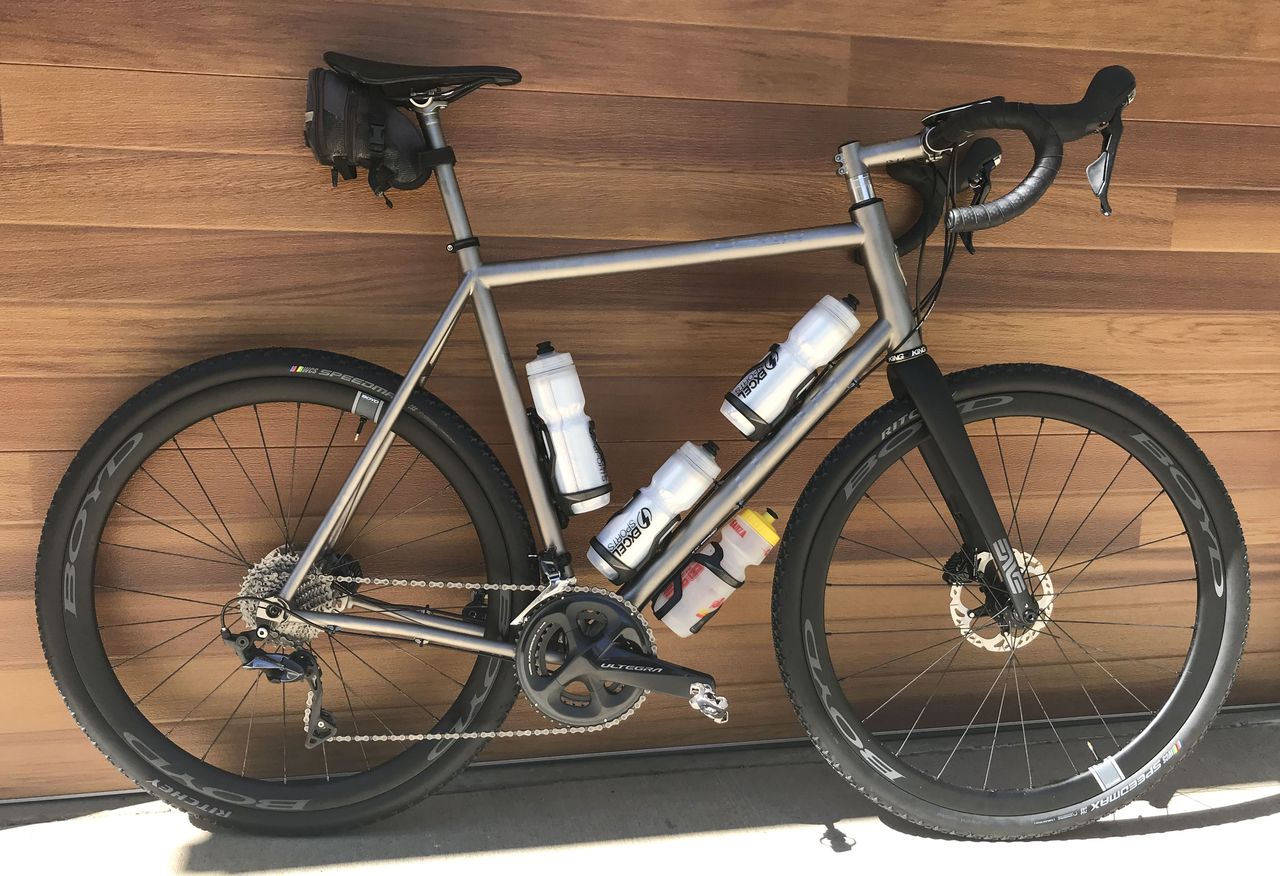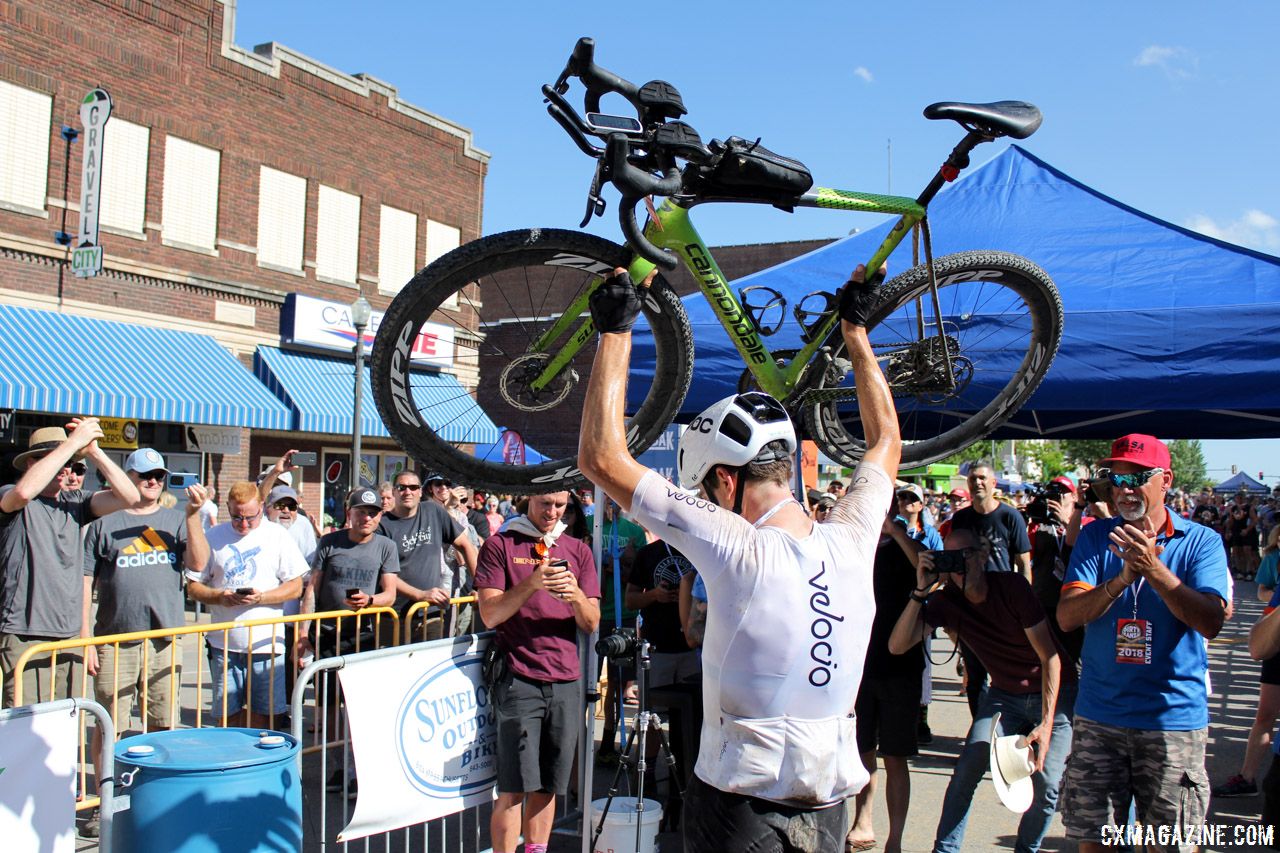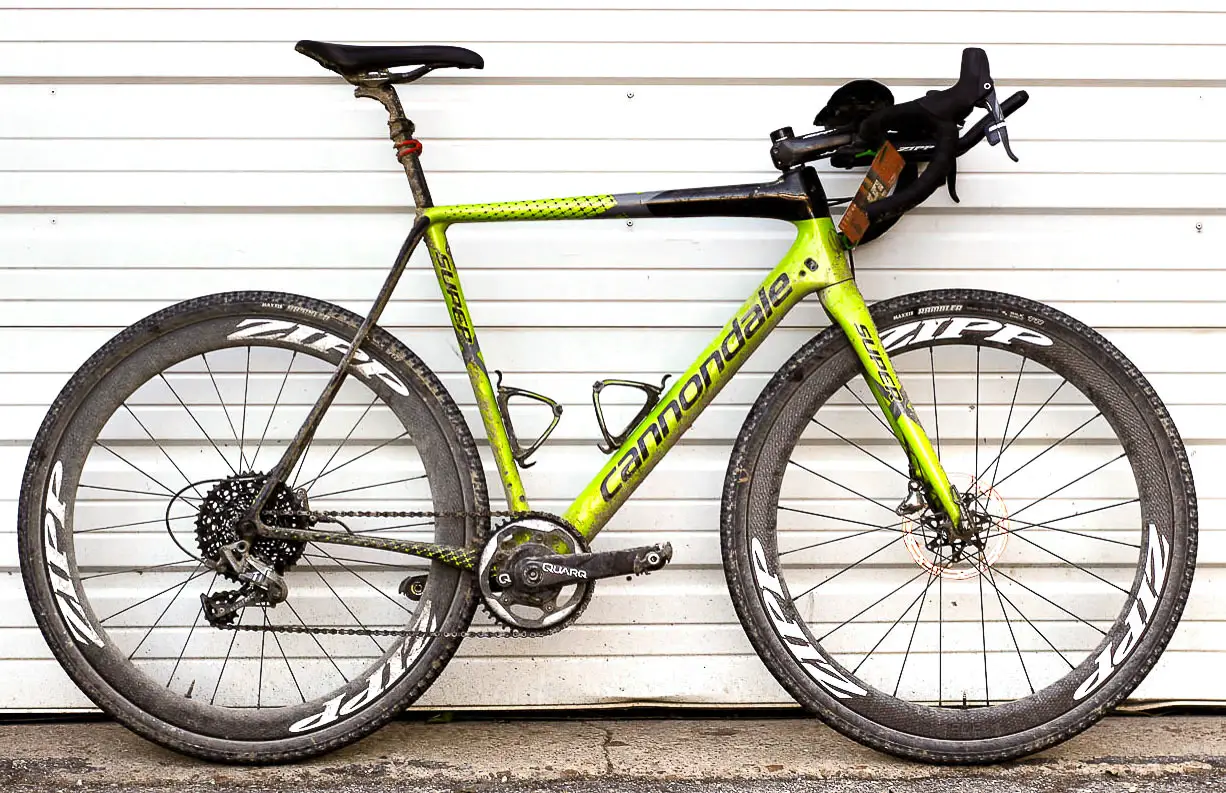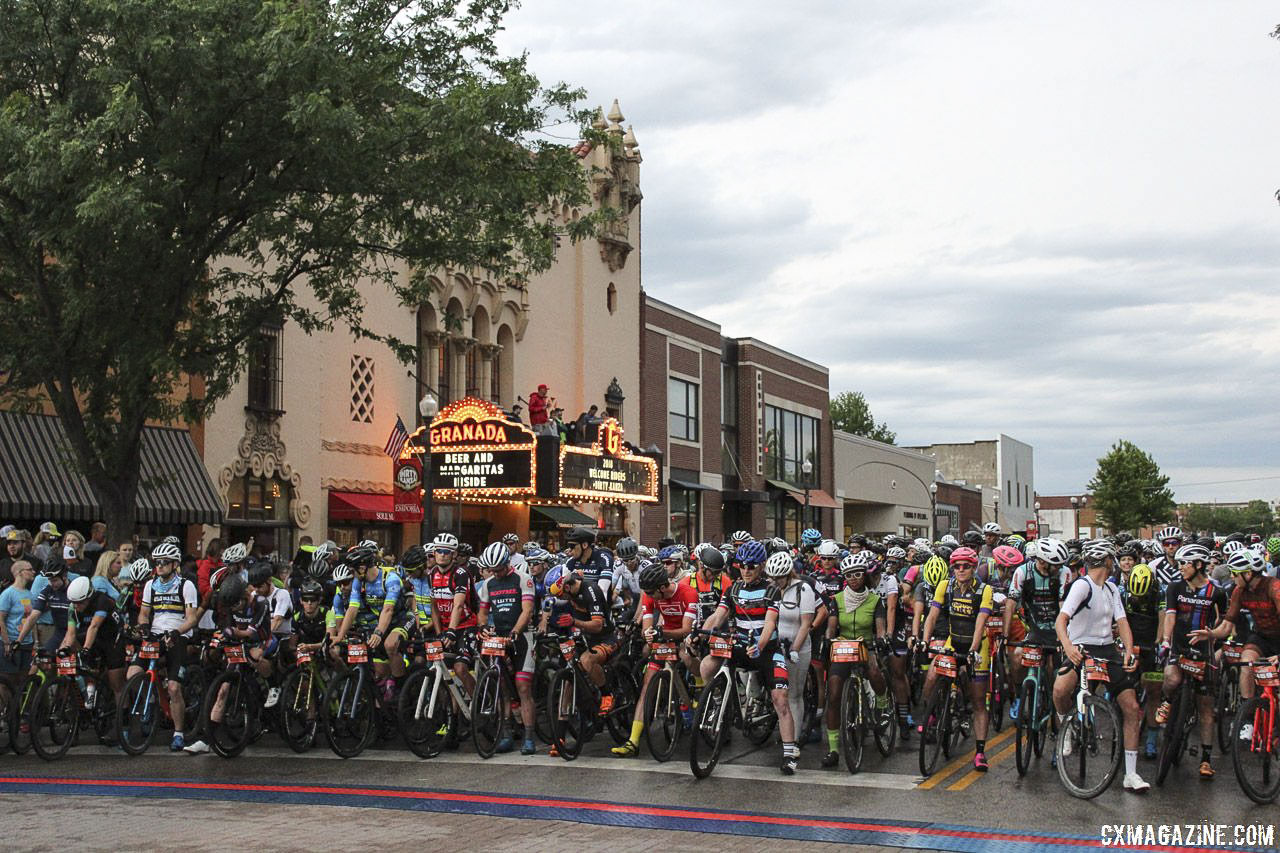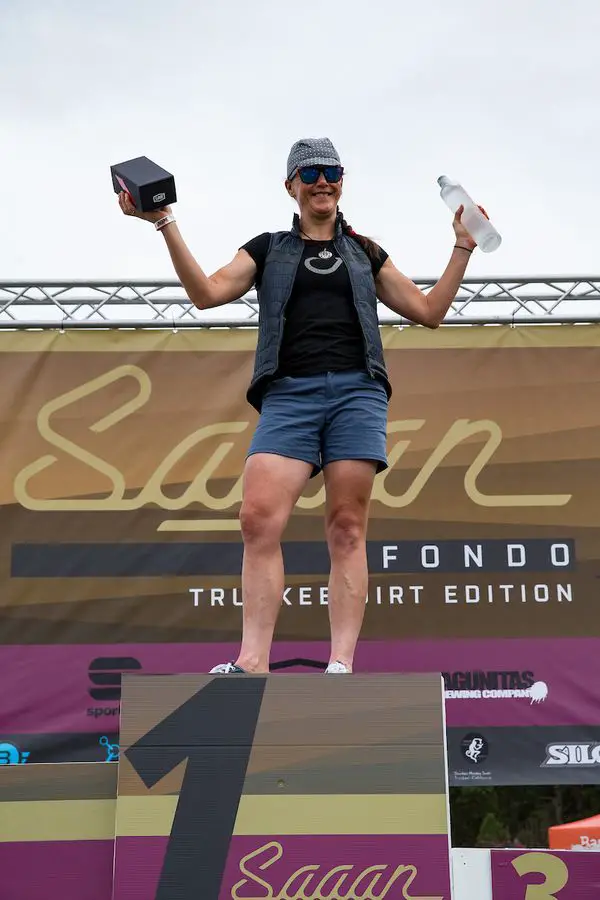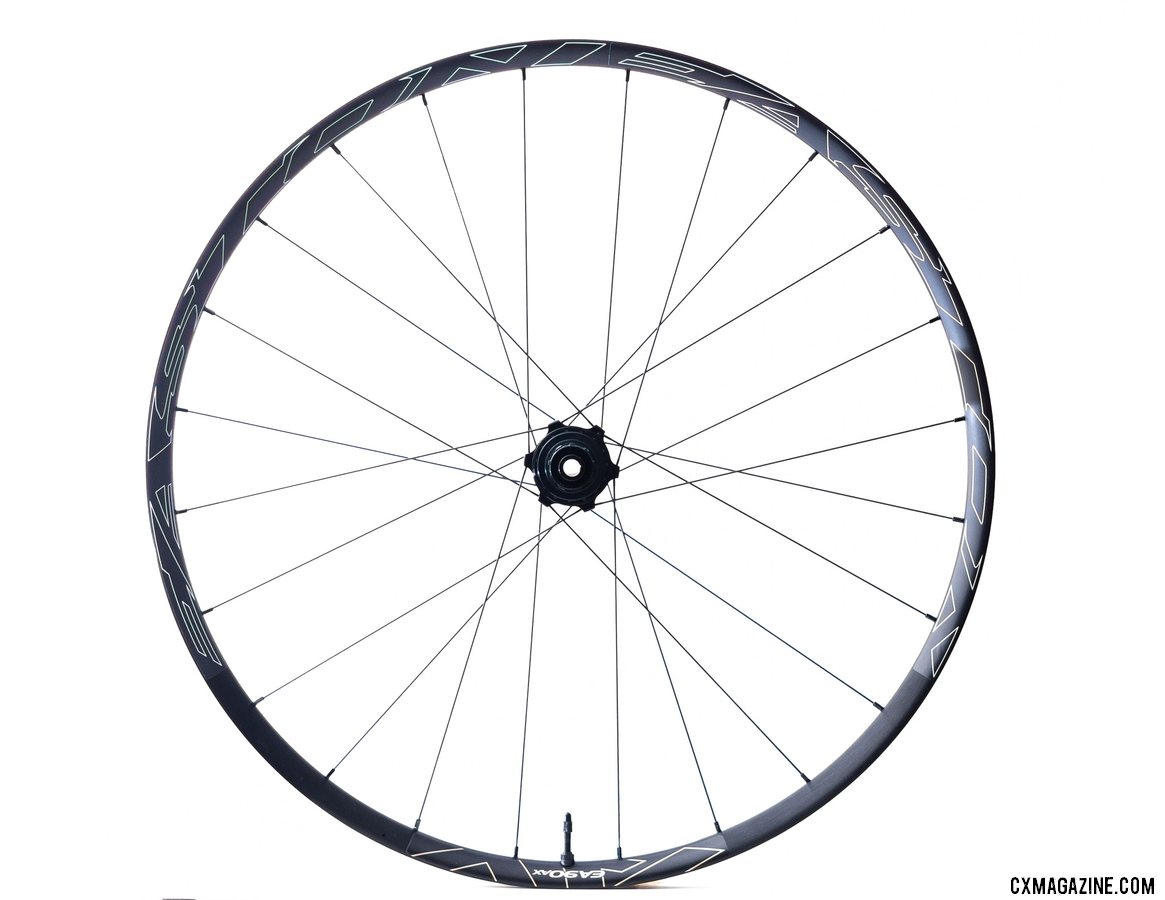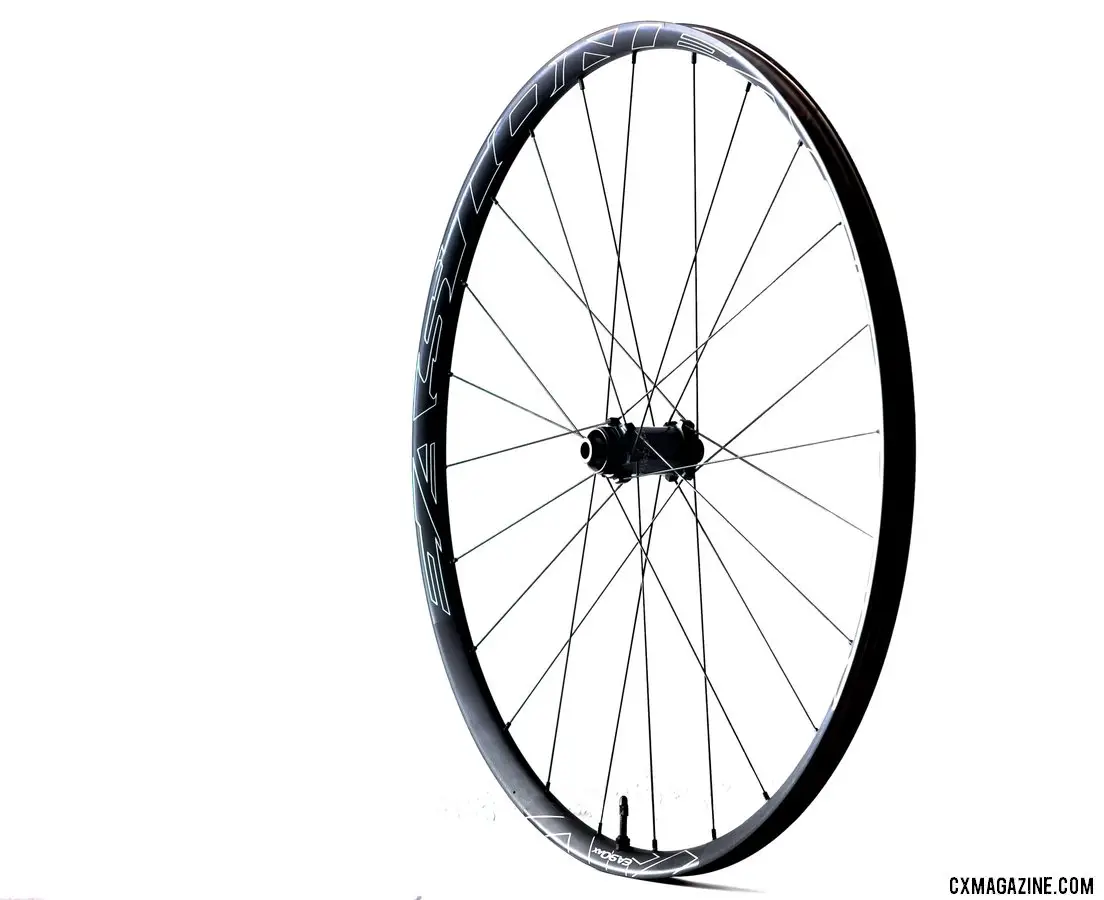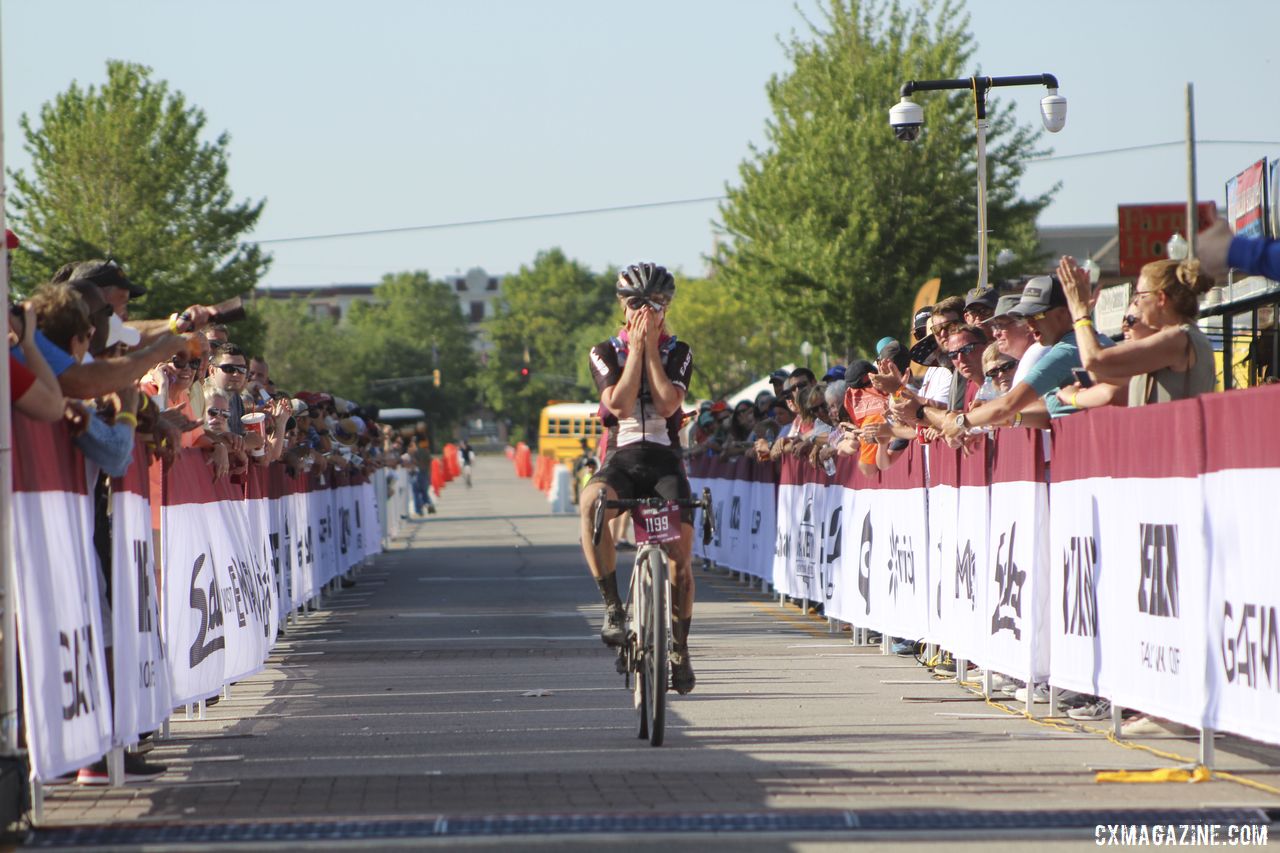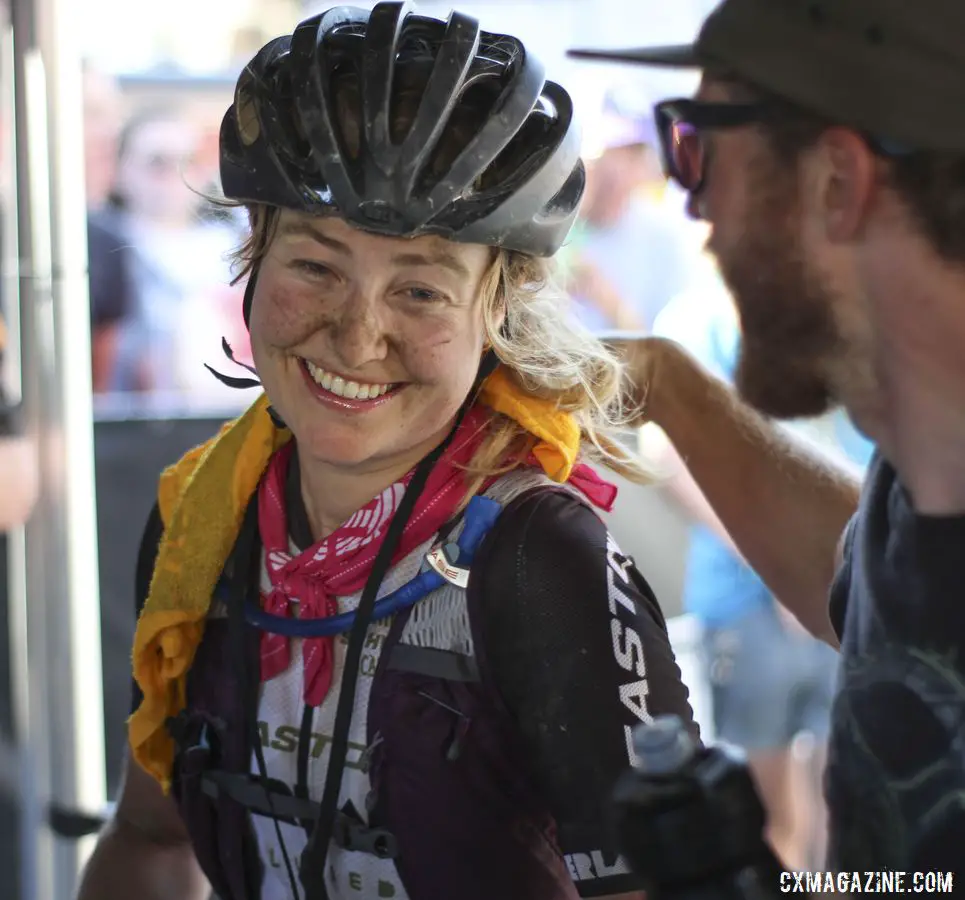
Thus far this spring, Anthony Clark ( ) has been a man about the Northeast gravel scene, racing at the front of races in both the U.S. and Canada.
) has been a man about the Northeast gravel scene, racing at the front of races in both the U.S. and Canada.
This interview was ostensibly supposed to only be about his gravel racing, but with Clark’s infectious energy and personality that matches his colorful Squid bike, we ended up covering so much more.
On the gravel front this year, Clark was one of the headliners for the Durty Bikes Series in Upstate New York. He took second to Curtis White (Cannondale p/b CyclocrossWorld) in close finishes at the Ossian Giant Gravel Grinder and Prattsburgh Gravel Classic before getting a win at the Hills of High-Tor.
[ICYMI, I interviewed White about his gravel grinding this spring]
Gravel grinding is nothing new for the Western Massachusetts resident. “I literally started doing it like six years ago,” Clark said. “This year was my sixth Paris to Ancaster. I just focus on being a full-time cyclocross athlete, and gravel has worked really well with that.”
Armed with his Squid cyclocross bike and now running tubeless tires year-round, hitting the gravel scene is an easy transition for Clark before getting things dialed in for the long cyclocross seasons he has been putting in.
“It’s really great because you can represent your cyclocross sponsors all year round, you don’t have to worry about getting a road contract, you don’t have to worry about changing your bike,” he said. “You literally just ride your ’cross bike and put fatter tires on it depending on what race you’re at. It’s frickin awesome. It’s like the best thing ever for a ’cross guy.”
The gravel-then-cyclocross approach has been working well for Clark. This past cyclocross season was his fifth with the Squid Squad, and when all was said and done, it proved to be perhaps his best yet.
Clark kicked his season off Down Under in Melbourne and by the time he wrapped up at Worlds in Denmark, he had raced in seven countries and brought home four wins, including three in Japan. He also finished fifth at Pan-Ams and podiumed at Gloucester, where he gave an all-time great post-race interview.
“Every weekend I was calling my son in tears because I was so happy and proud of myself,” Clark reflected. “Other years I have been really proud, but I think my first year as a pro I literally finished 5th 18 times. I was just so frustrated because it was fifth place every weekend. It felt so good this year to always be fighting for the win or the podium. It was just so nice calling my son and telling him how I was doing.”
As mentioned above, I started out chatting with Clark about gravel racing, then we covered some cyclocross, his training, hanging with Jeremy Powers and Stephen Hyde and a whole ton of other things. Whut?!
You can read a transcript of our conversation below.
Interview: Anthony Clark on Gravel, ’Cross, Family, SickWhats
Cyclocross Magazine: Are you out in Sacramento, are you out East? You’ve been racing a lot out East?
Anthony Clark: Nah man, I’ve always lived in Massachusetts. I train in California sometimes. Last year I went out in June and did Lost and Found. Dude, everybody always asks me that, “Dude, how’s living in California?” I’m like, “Dude, I’ve lived in Western Mass my whole life.”
CXM: Haha, I thought you moved out there, but I guess I’m with everyone else in being wrong.
AC: It’s totally cool. It’s a question I answer literally every day. My kid’s here, I couldn’t move.
CXM: Let’s talk some gravel racing. How long have you been doing the gravel thing?
AC: What?! I literally started doing it like six years ago. This year was my sixth Paris to Ancaster. I just focus on being a full-time cyclocross athlete, and gravel has worked really well with that. It’s different than road racing. It plays to my advantage more. I would always do Battenkill and Paris to Ancaster. I would always line up for like four gravel races with a road season, then as more gravel races popped up, I didn’t have to do as much road racing.
I would do like six, seven gravel races a year and then maybe one road race. Then bam, go and do a 30-race ‘cross calendar.
CXM: Is gravel your quote-unquote base training for the year now?
AC: Yeah, it’s kind of like one of those things where you start training for the year, I don’t really take any time off. Maybe I take one week off per year. This year, I started gravel racing for some intensity in the spring, and then after that, I kind of switch over to doing more speed work in July and August to get ready for cyclocross.
It’s really great because you can represent your cyclocross sponsors all year round, you don’t have to worry about getting a road contract, you don’t have to worry about changing your bike. You literally just ride your ‘cross bike and put fatter tires on it depending on what race you’re at. It’s frickin awesome. It’s like the best thing ever for a ‘cross guy.
CXM: Are you seeing value for Squid and your other sponsors from doing more and more gravel races?
AC: I think the way my sponsors are set up I get to represent them with my own lifestyle. And then going to races, going to cool events and doing a full ’cross season, I think it all adds up. I’ve had the same sponsors for going on six years now. It works great for me. We have a great relationship. I don’t like changing a bunch of stuff like that. I think it works out really well.
You wouldn’t believe the number of people who turn out for these gravel races. It’s like an ocean of people. It’s pretty awesome.
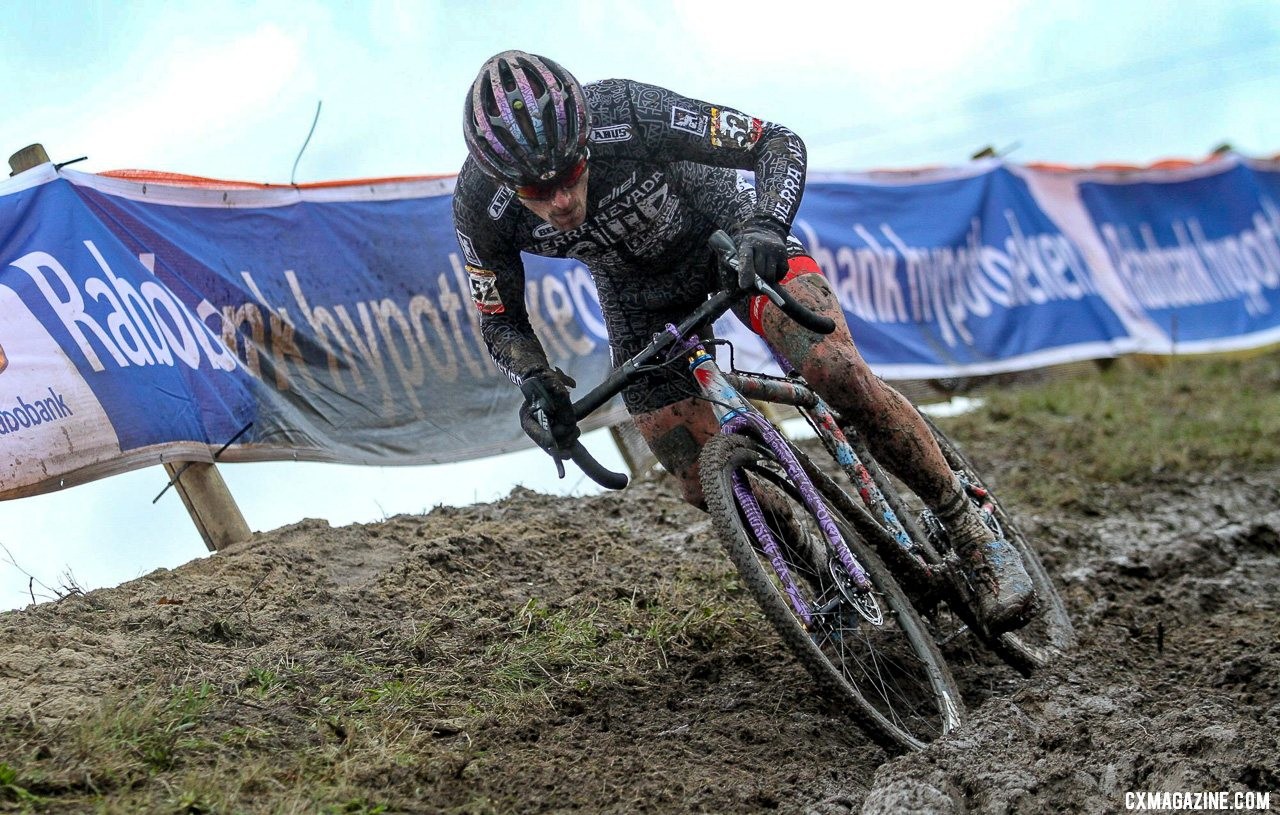
Anthony Clark has been repping the Squid Squad across the world. Elite Men, 2019 Hoogerheide UCI Cyclocross World Cup. © B. Hazen / Cyclocross Magazine
CXM: It seems like Squid is a really good fit for you. You literally got to see the world this year. Could you ever see yourself being on Stu’s team with Cannondale?
AC: Nah man. That works great for like Stephen [Hyde]. Stephen is just super pro and legit. I’m also pro, but I don’t know, my style fits better with Squid. Stephen fits really well with Cannondale. I think that’s the beauty of ’cross racing. You get a diverse group of people.
I mean Stephen has been with Cannondale as long as I’ve been with Squid. It’s one of those things where you build the team around you so it matches your personality. With ‘cross and gravel racing, we all get to race each other in a situation that works for us.
CXM: Speaking of racing people from across disciplines on gravel, I did an interview with Curtis [White], and he said the toughest part of his spring has been trying to drop you. What’s it been like racing against him and some of the other cyclocross guys?
AC: Whut?! Aww, I frickin love riding with Curtis because he never … lets … up. All day, we just smash our faces in. There was one point where JPows was in the break with us, and he was like, “Come on guys, I’m hanging on here.” It was just attack after attack.
Curtis said, “We’re not going to get any better if we don’t keep attacking each other and forcing ourselves to get better.” I agree. Every race with Curtis would come down to a sprint because we would refuse to stop attacking each other.
It’s so cool to be competitive during the race, but after the race, it’s super fun to hang out with Curtis. He’s a funny kid. That’s how it is with everyone. We’re all super close off the bike, joking around, riding, training together.
Stephen and I go train together and hit trails together. You just want to push each other to get the best result possible for you, but you don’t want to let somebody just get the win. It’s really nice to have that competitiveness with each other and still be friends.
CXM: I think it makes it more fun for us to cover you guys because you are all friends. You’re coming off one of your best seasons as a professional cyclocross racer, and it seems like everyone has stepped up to just smash faces every week. Has that made you a better rider and has that been frustrating at times?
AC: I used to get frustrated. I would say the first two years of me being a pro I would get frustrated by it, but the past three years, I would say have been the best years I’ve had so far. Instead of getting frustrated, I learned to just embrace it and work harder. I would try to train off of it. I worked on doing more motor pacing.
Then when I go to the races, I’m super calm during pre-ride, but then when it’s go time, it’s go time. I just try to ride in the group. I look who’s going strong and say whatever and try to go to the front.
I’ve tried to race my own race instead of racing everyone. If you’re trying to race certain people, that can get in your head and you can get weird animosities. I don’t really want that kind of toxicness inside me. I try to race the group of people I’m with. I don’t really care who’s in the group with me, I just try to win whatever group I’m in that day.
Everyone has stepped it up so much. I like it. It’s one of those things where if you’re fast that day, you just keep riding with them and say, “Hell yeah. That’s what we do.”
CXM: I don’t know if I got to catch up with you in Denmark, but how did Worlds go?
AC: It was pretty awesome. I got my face kicked in. I wanted to get like top 25 super bad. I trained super hard for it. It was just a flat, really windy course, I did my best. The first two laps I was in the top 30 and then slowly dropped back. Then Cody [Kaiser] and I kind of did a time trial together and helped each other, and then we both got pulled at the same time. I did the best I could and I’m proud of what I did, but it’s just ironic because both times I’ve been to Worlds, I’ve literally finished 43rd both times.
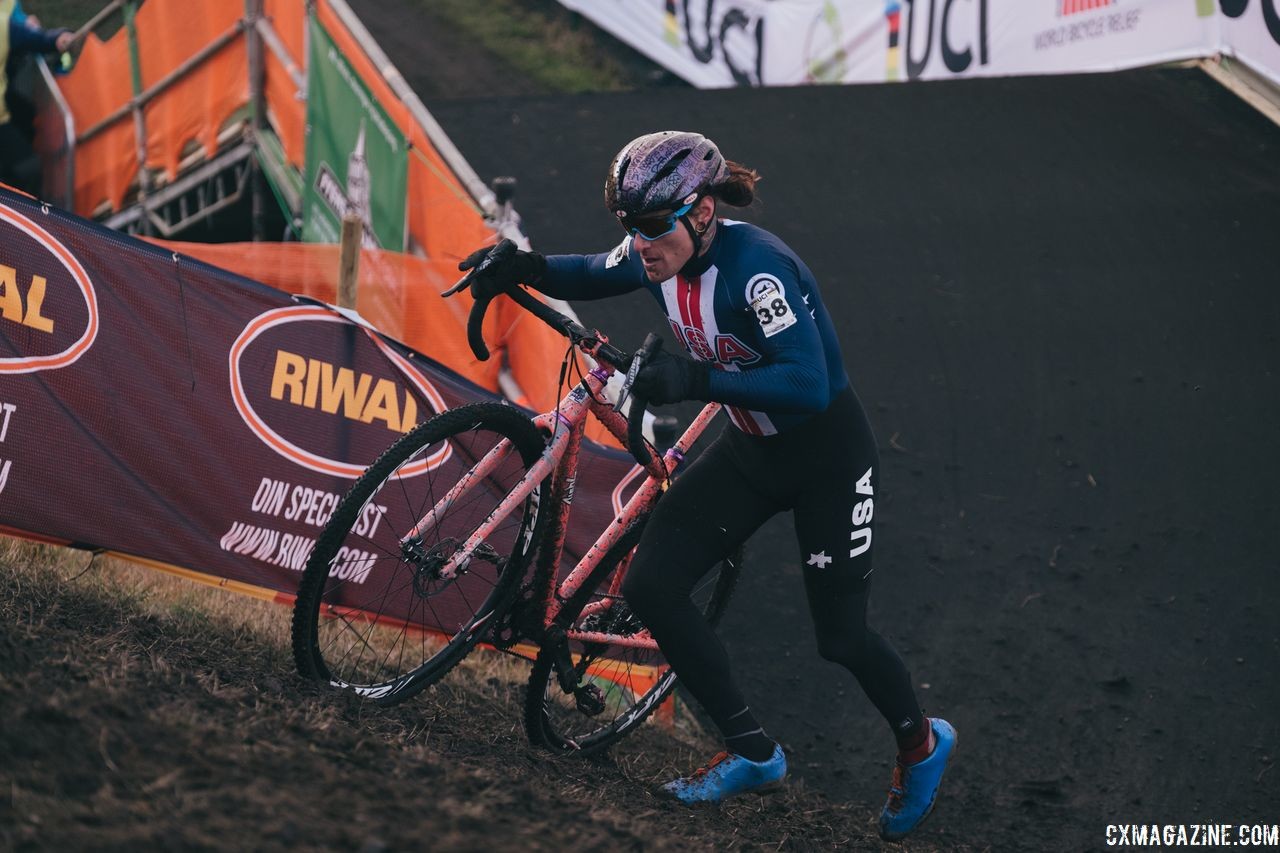
Anthony Clark represented Team USA at Worlds. 2019 Bogense Cyclocross World Championships, Denmark. © Patrick Means / Cyclocross Magazine
CXM: Making the Worlds team will be a big goal for you this coming season to improve on that 43rd then?
AC: I used to always have to petition for it, but it would get lost. I petitioned two years in a row, and then I got selected in 2016. Then this year, I knew it was one of the few years I’ve gotten to dial all my training in instead of working a ton. I wanted to just make it. The whole year I just crushed the season. I wasn’t super stressed and was super positive about it.
Nationals, I went in and was healthy. I knew it would be good for me because it was muddy with a ton of running. I knew all I had to do was get a top 10 to hold my top 5 ranking in the U.S. It wasn’t like I was automatically qualified, but like JPows said, he was like, “Dude, you’re fifth in the country. There’s no way you’re not going.”
It felt really good to be selected for the team without having to petition for it. It felt good. They only took five Americans and I was one of the five. It was a really great way to cap off that season. I think I won three or four races; I’ve never won that many in a season.
Every weekend I was calling my son in tears because I was so happy and proud of myself. Other years I have been really proud, but I think my first year as a pro I literally finished 5th 18 times. I was just so frustrated because it was fifth place every weekend. It felt so good this year to always be fighting for the win or the podium. It was just so nice calling my son and telling him how I was doing. The last five years have just been awesome.
CXM: I was thinking back to the race at Pan-Ams where you finished fifth, I think. That was an insane day of racing, and you raced so well. It was awesome to see you consistently turning in good results literally across the world.
AC: Watt?! Ah man, it is really profanity awesome man. Wut? The last two years, we’ve really done the Squid World Tour. All these big UCI races stared popping up, and we were like, we’ll just go to those. I was really happy I got to do it. I know this year we’re going to do more of the American circuit. Do the World Cups here like last year. I don’t know if we’ll do another World Tour, but for two years I’m happy I got to do it because it was really sick.
I tell people you can’t buy experiences. The last decade coming up through the JAM Fund and then racing for Squid going on my sixth year, I tell people you could give me $5 million but I’d have to give back my experiences and I would say hell no. There’s no price tag on it. Everything I’ve worked for and done. If I sit here and think about it, I might start crying because I’ve done some of the coolest things I’ll probably ever do.
CXM: Speaking of your son, how old is he and is he riding bikes yet?
AC: He rides BMX bikes with me. He’s 10. I’m trying to get him into faster bikes, so we’re going to go pick out a new bike this summer. I’m going to see if he wants a mountain bike so we can trail shred together in Robinson. I do my training during the day, but after work, we’ll go ride BMX bikes. I would love to go ride some trails with him.
CXM: BMX is how Sven started, and there are a number of other folks who started racing BMX, so who knows where it will go.
AC: That’s what I said. I figured I’m not going to push him, I’m going to let him see. I don’t want to push bikes on him, but I will let him know that dude, this bike rides better in the woods. Then he’ll be like, “This is sick.” And I’ll be like, “This is sick.” And then we’re just being sick together.
CXM: So maybe we’ll see him at Cyclocross Nats sometime soon?
AC: I don’t know if he’s smooth enough on his bike yet. We’re working on it.
CXM: Fair. We’re just bouncing around here, but going back to gravel, it seems like the scene really fits your personality. Is that the case?
AC: I think so. With how busy my family business is and stuff, it was getting super hard to go do big road races and try to get on a road team. It’s really easy to escape for a gravel race weekend. It suits my power abilities a lot more. Road racing is a lot of cat and mouse. That’s fine, I do like it once in a while, but the gravel scene and a couple of road races works out so much better for me.
CXM: The dudes who have been throwing down against you have talked a lot about your climbing. Have you always been a good climber and is that something you work on specifically?
AC: I’ve always been really good at it, and there aren’t really any flat rides out here. Every day I ride three to three and a half hours. I do 2,000 to 5,000 feet of climbing every day. I don’t really train with heart rate or power a lot. I train with those like once a week if that. I usually just do it by feel, and I have for years now because I can’t handle all the anxiety of training plans and stuff. I know that sounds ridiculous, and people are like, “I don’t believe that!”
I have training plans from Al at Cycle-Smart that I kind of follow, but basically I just do it by feel. If I feel really good that day, I just go and just smash it. I’ll go pick a 3-hour loop with like 5 15-minute climbs, and I’ll just go and slay all of the climbs. If I think I’m going too easy, I’ll start going harder and harder. It’s one of those things where you don’t know how hard you’re going, but you’re going really really hard. I’m probably overtraining a bit, but it feels better to me than looking at a screen.
I train with a computer, but just to track my mileage so I can log it. Your power numbers vary, and they can mess with your head. If you don’t have any power numbers to mess with your head, you’re never in your own head at a race. It’s just like, eh, I feel good today. You’re not like, “Oh my gosh, my power is 25 watts lower, what am I going to do?”
CXM: Cyclocross has some specific skills you need to develop. You can be a smasher, but you still have to be able to do short bursts and stuff like that. Do you work with your coaches on getting those workouts in your training?
AC: I guess the biggest thing I did is I got 37mm road tires from my sponsor, and I ride on them every day. I ride trails, I ride dirt roads, I ride gnarly stuff. All on road tires. Ever since I switched, I can hang with Stephen training now. I used to get dropped by him every two seconds. It’s really really helped because if you can corner that fast on road tires, you can certainly do it with a little bit of tread. It always makes me more confident on the bike and correct things faster. I’m not as shaky.
Honestly, that’s the biggest change I’ve made. I’ll go on training rides with Powers, and I’ll have road tires on. We’ll be in Robinson slaying each other on the trails riding road tires. I used to get butthurt about it when I would get dropped, but now it’s like a mission not to get dropped while riding slicks. I’ll train with people who are like, “Holy shit, this guy’s on road tires, are you kidding me?” They might be 37s, but they’re still slicks.
It teaches you weight transfer really well. If you’re going up a steep, loose climb, you have to transfer your weight so your tire doesn’t spin. You learn it’s nothing about tread, it’s where you have your weight when you’re cornering, how you feather your brakes so you’re not washing out and drifting the corners. Drifting is okay, washouts are usually because you’re not controlling your brakes correctly. I’m not saying I don’t crash, I definitely crash. The only way you’re going to get fast is pushing the limits.
CXM: Do you do all this on your Squid?
AC: All this on my Squid. I don’t own any other bikes. I literally haven’t ridden a different bike since, let’s see, I started riding a Squid in April of 2014, so I haven’t ridden another bike since April of 2014.
CXM: We’ll say a while.
AC: It’s been a while, and I haven’t been on anything but Squid. My mountain bike is a Ventana, which is made by the same company. Ventana welds all the Squids, so it’s basically a Squid. My road bike that is coming next month will be a Squid.
CXM: Doing all that ripping, whether it be gravel, cyclocross, trails, on the same bike, do you think that has been helpful?
AC: Yeah, I think so. It’s just a super comfortable bike. I’ve even done some road races on it. I got second at a road race last year on it. It’s super fun. I just put open tubulars on it. I didn’t do any crits, but I am going to do NE Crit Week this year on the new road bike. They just released a steel road bike. I’m pretty stoked.
CXM: Would you ride carbon if you had to?
AC: Ahhhhh, I don’t know man. I’m a metal bike kind of guy. People are like, “Oh it’s heavy.” It’s like, “No it’s not. I’m pocket-sized. I’m 5’5″ at 135 pounds. My bike weighs 17 pounds.” I don’t care about a gram. I have full Zipp everything, my bike is ridiculous. I don’t want carbon. Carbon breaks.
You know how many Squid frames I’ve broken? Zero. And I ride like a jerk. One time I tried to hop a park bench, and I slipped and smashed the downtube at like 20mph and it just dented it. I raced on that bike all year with a dented downtube. It was totally fine.
I remember Chris was rebuilding it, and he was like, “Dude, what the eff happened?” “Nothing,” I said. He goes, “Dude, what the eff happened?” It was totally fine. The bike I went to Worlds on in 2016 had a dented down tube. It’s totally fine, and that bike is hanging on my wall now. I trained on it all through winter, and was like, “You know what, I don’t want to ride this bike anymore because if anything happened to it, I would be heartbroken.” Now I see it every day.
Then the bike I took to Worlds this year, I think after this summer I’m going to hang that one up too. I don’t want a car to hit me or something bad to happen to my bike. We’ve been through a lot together.
CXM: How do you balance ripping and being a jerk and not killing yourself?
AC: I don’t. I wear a helmet and act first and think later. That’s how I live my life. It usually works out, but some times it definitely doesn’t. It’s totally fine.
CXM: What’s the biggest thing you’ve learned from riding with JPows and Stephen?
AC: I’ve learned a lot from Stephen technically. He’s taught me a lot about riding my bike just from training with him. JPows has done the same. JPows has really helped me in the sand.
The biggest thing JPows and I have figured out by training together over the years is the reason we race, the reason we ride bikes is because we love it. And if you stop having fun, you’re not doing it right. It’s really that simple. You ride your bike a lot, you’re going to be fast.
Then you go race your bike, and some weeks you’re 1st, some weeks you’re 5th, some weeks you’re 10th. Whatever man. It’s all the same. We’re just racing. You can’t win them all. You can try. We all try every time to win them all. Shit, Paris to Ancaster there were 20 people on that front line who could win that race. It’s like 20 people killing each other all day trying to win a bike race. It’s like, “Hey, not every day is your day.”
CXM: That’s kind of what JPows said about retiring. He was like, “I still want to win,” but his wife responded, “Yeah, everyone wants to win, and they’re younger than you.”
AC: It just gets harder every year you get older. You’re trying to buy a house and do all these things as you get into your 30s. Bike racing works when you’re younger, but when you get older, you need a little bit more money and you’re trying to make everything work. And when you get older, life gets more demanding. By the time you’re 36, it’s kind of hard of racing with these guys who are like 24. You get tired when you get older. There’s nothing you can do about it.
That’s the way it’s supposed to work. You race for a decade to 15 years, then the young kids who looked up to you start kicking your butt. Then you sadly start nodding your head and saying, “I guess I’m going to have to start racing less.”
CXM: I’m 36, and I go ride with the kids who go to college in my town and it’s like, “Oh my gosh, you guys are so strong and talented. You kids are better than me and you don’t even try.”
AC: There’s a photo of Curtis and me racing together at a NYCross race together like 9 or 10 years ago. He was a little kid. He was like 14 years old, and I was like, “Ah, I don’t have to worry about this kid.” Now he’s come up, and he’s a monster. Racing with that guy, it’s like, “Dang Curtis, I can’t go any harder. Stop it. Stop.” He’s so frickin talented, he’s good technically. It’s pretty cool to see him come up and start smashing everyone.
Spencer [Petrov]. Spencer is a great kid and super fast. Lance [Haidet]. Lance is another one. He’s so strong, and he’s such a nice kid. I love racing these guys because you’ve gotten to watch them grow up and race with them. They change from these punk teenagers into grown men who are kicking your butt. It’s like, “Dang it, why couldn’t you just stay a punk teenager?” Tobin [Ortenblad], Lance, Cody [Kaiser]. I remember seeing them as teenagers and now they’re aging up and smashing.
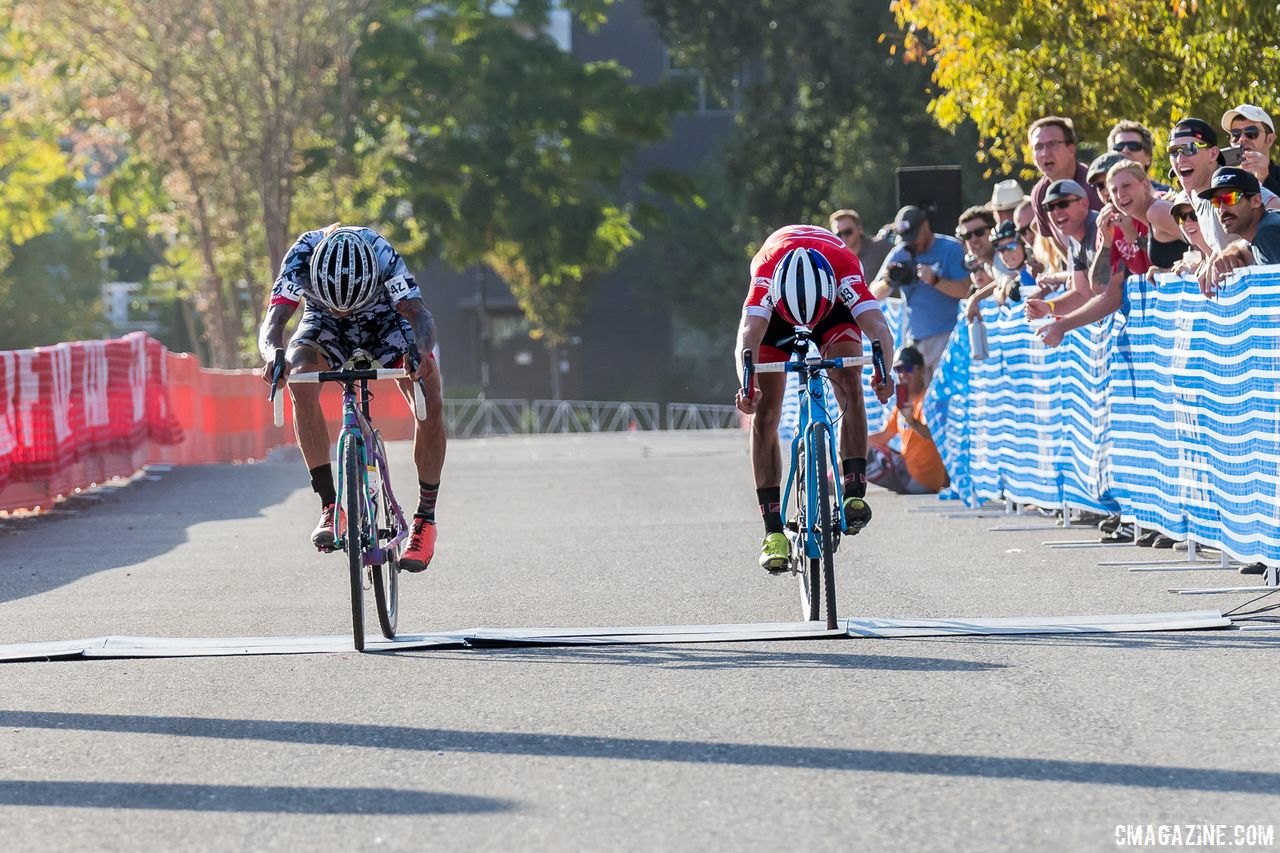
Clark topped one of his young rivals at the 2017 West Sac GP. 2017 West Sacramento GP (Saturday). © J. Vander Stucken / Cyclocross Magazine
CXM: We admittedly have our favorite riders, but this year at Nationals, I was literally cheering for everyone in the field. There are just a lot of great dudes who are racing. and you’re all so fast. It makes it fun to cover.
AC: I was talking to JPows a long time ago, and we were talking about making the scene a community where we all want to do well, but nobody wants any animosity or hate. You don’t want it to be where you want to beat a guy because you hate him. I want to win because I ride my bike a lot and just want to win the race. I think it’s great because everyone just shreds each other’s legs off and it’s great to watch. Then at the end, we all hang out, and it’s like, “Can’t wait to get you next week.”
CXM: Speaking of shredding, what are you up to the rest of the summer?
AC: I’m going to do the Black Fly Challenge. I want to do New England Crit Week. Then in July, I’m just going to train, help my dad out with work and hang out with my kid every Sunday. Then August I’m going to do Vermont Overland, and then in September we start the cyclocross season man. I’ll know my full calendar in a week. That’s pretty dope.
CXM: What’s your family business?
AC: My dad owns a rental company, so I lift heavy stuff all day, drive trucks, set up tents and get buff. I ride my bike three hours every day at lunch time. I work anywhere from 40 to 50 hours a week. It’s not bad. It helps keep me skinny.
CXM: How does that work training while you’re exhausting yourself at work?
AC: I don’t know, I’m tired a lot. It’s the path I have and the path I fell into. I used to try to fight it and ride a lot more while working less. But as I got older, I’ve decided to fight it less. I can win any race I want to. I ride so much that it will be fine. Ever since I stopped stressing, it just got easier. It sounds ridiculous, but it works out pretty well. Some days are hard, but you have easy days and you have hard days. Whatever.
CXM: Like JPows said, everyone has their own path that they take, and they make it work for them. For him, he was doing JAM, he was doing Behind the Barriers, and he somehow made it work.
AC: JPows is like me. He doesn’t really function very well unless he’s needed. At the end of the day, like Jeremy told me, “Ant, even if you made a million dollars, I guarantee you that you’d still be helping your dad because you’re not one to say no when someone needs help. Every time I look at you, you’re helping somebody else.” It’s because I need to be needed or I don’t really want to do stuff every day. I like to help people.
JPows needs to help people all the time. He was the sickest pro racer ever, and then he started helping all these people. He started JAM and helped a bunch of us come up through it. It’s one of those things where we all have personalities and you just have to embrace them.
CXM: It’s been awesome chatting with you man.
AC: Dude, it’s been super dope.
CXM: I’m looking forward to seeing you smash this fall.
AC: Hell yeah brother.
Featured image: Jeff Curtes
The post 🦑❤️🚴♂️🌪️🔰🌎: Anthony Clark’s Path Includes Cyclocross, Gravel, Family and SickWhats appeared first on Cyclocross Magazine - Cyclocross and Gravel News, Races, Bikes, Media.



